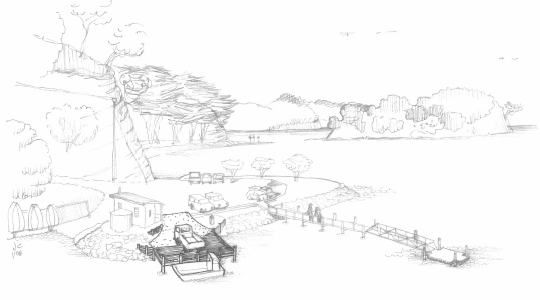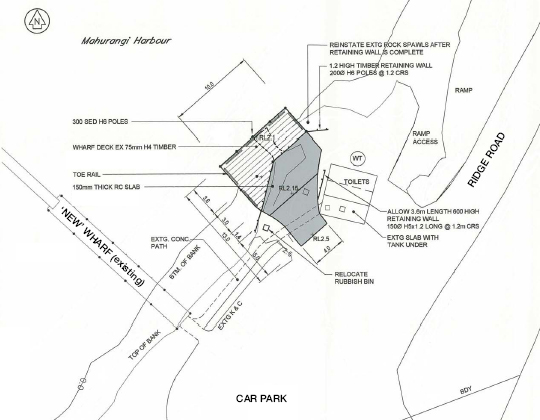Proposed Scotts Landing wharf would reduce traffic

Seagull’s View: Concept designed to improve harbour access for oyster farmers while reducing congestion at Scotts Landing, including through the use of a fewer number of self-loading trucks rather than the predominant practice of utilities and trailers operating from the crude secondary boat ramp, to left of proposed wharf in this view. rendering Jefferson Chapple
Scotts Landing’s new wharf has proved to be wonderfully successful.
As local oyster farmers, our frequent use of the landing means that we get to see just how well it works—from kids fishing through to loading provisions and crew aboard local yachts, and simply as a place for locals to socialise. It is very decidely a pedestrian wharf, which is large part of its appeal.
Meantime, local boat owners need a wharf to load and unload heavy articles and for removing and replacing equipment for repairs. And oyster farmers need a wharf to load and unload oyster barges.
So, we oyster farmers asked Davis Coastal Consultants to draw up a concept for replacing the old concrete wharf with a structure that fulfils the need to get vessels and vehicles alongside.
- A tidal wharf will suffice, as nearly all boats can get in—at least at high tide. They don’t need to use it often, but it is very important when they do.
- Oyster farmers at present use the beach behind the toilets. With the sloping, uneven surface, this is unsuitable and even dangerous for self-loading trucks. It is preferable that the farmers go to small trucks as each such vehicle carries as much as three utilities and trailers. This should reduce the present five or six vehicles to three or four, a useful saving with the limited parking there.
- The present concrete wharf and bank behind the toilets is a mess, and looks more so now that the new wharf is built. The facility can be made more useable and at the same time tidy the waterfront and harmonise with the new wharf.
- There will be no conflict between the oyster farmers’ use and the boat owners uses as the oyster farmers would use the wharf at the bottom of the tide and the boaties at the top.

Proposed Vehicle Wharf: By siting the proposed vehicle wharf largely behind the toilet building, and loading and unloading oyster barges there, a useful area of beach is freed up for other boat users. plan Davis Coastal Consultants
- There will be no increase in traffic. All the moorings are already occupied and there can be no more oyster farmers than the three that use Scotts now. In fact the oyster farmers’ vehicles will decrease by one or two.
- The beach behind the toilets would be freed up for small boat launching at low tide and free of trucks at all times.
- As the oyster farmers can park in front of the wharf at low tide when boats can’t use it, the number of parks will be increased. In the weekends when oyster farmers do not generally work, parks will be increased further.
- Design and construction can harmonise with the new wharf and give a consistent attractive timber theme to all sides of the landing.
- The oyster farmers are prepared to make a significant contribution in both materials purchase and labour.
